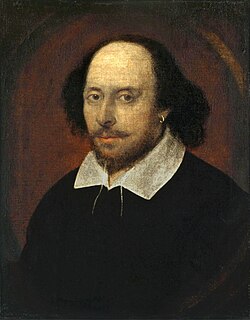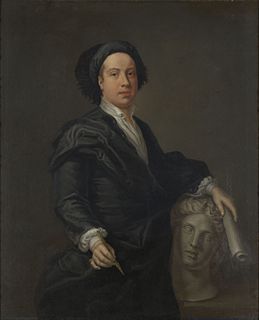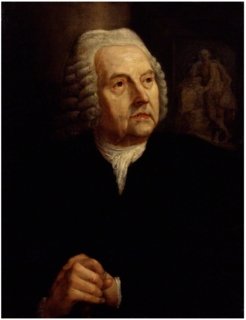 W
WThere are only two portraits that definitively portray William Shakespeare, both of which are posthumous. One is the engraving that appears on the title-page of the First Folio, published in 1623, and the other is the sculpture that adorns his memorial in Stratford upon Avon, which dates from before 1623. Experts and critics have argued that several other paintings from the period may represent him, and more than 60 portraits purporting to be of Shakespeare were offered for sale to the National Portrait Gallery within four decades of its foundation in 1856, but in none of them has Shakespeare's identity been proven.
 W
WThe Ashbourne portrait is one of the numberless portraits that have been falsely identified as portrayals of William Shakespeare. At least 60 such works had been offered for sale to the National Portrait Gallery in the 19th century within the first forty years of its existence; the Ashbourne portrait was one of these. The portrait is now a part of the collection of the Folger Shakespeare Library in Washington, DC.
 W
WThe Chandos portrait is the most famous of the portraits that may depict William Shakespeare (1564–1616). Painted between 1600 and 1610, it may have served as the basis for the engraved portrait of Shakespeare used in the First Folio in 1623. It is named after the Dukes of Chandos, who formerly owned the painting. The portrait was given to the National Portrait Gallery, London on its foundation in 1856, and it is listed as the first work in its collection.
 W
WThe Cobbe portrait is an early Jacobean panel painting of a gentleman which has been argued to be a life portrait of William Shakespeare. It is displayed at Hatchlands Park in Surrey, a National Trust property, and the portrait is so-called because of its ownership by Charles Cobbe, Church of Ireland (Anglican) Archbishop of Dublin (1686–1765). There are numerous early copies of the painting, most of which were once identified as Shakespeare. The Cobbe original was only identified in the collection of the Anglo-Irish Cobbe family in 2006, and had until then been completely unknown to the world. Evidence uncovered by researchers at the Shakespeare Birthplace Trust led to the claim, presented in March 2009, that the portrait is of William Shakespeare and painted from life. Many scholars dismiss this theory and have provided evidence to identify the portrait as one of Sir Thomas Overbury. The portrait has been the centrepiece of two exhibitions dedicated to it: Shakespeare Found: a Life Portrait at the Shakespeare Birthplace Trust, Stratford-upon-Avon, from April–October 2009 and The Changing Face of William Shakespeare at the Morgan Library and Museum, New York, from February–May 2011. An illustrated catalogue provides details of the painting and its provenance.
 W
WThe Droeshout portrait or Droeshout engraving is a portrait of William Shakespeare engraved by Martin Droeshout as the frontispiece for the title page of the First Folio collection of Shakespeare's plays, published in 1623. It is one of only two works of art definitively identifiable as a depiction of the poet; the other is the statue erected as his funeral monument in Shakespeare's home town of Stratford-upon-Avon. Both are posthumous.
 W
WThe Flower portrait is the name of one of the painted portraits of William Shakespeare. A 2005 investigation of the portrait led to the conclusion that it was a forged artwork painted in the 19th century.
 W
WThe Shakespeare funerary monument is a memorial to William Shakespeare located inside Holy Trinity Church at Stratford-upon-Avon, the church in which Shakespeare was baptised and where he was buried in the chancel two days after his death.
 W
WGerard Johnson was a sculptor working in Jacobean England who is thought to have created Shakespeare's funerary monument. In May 1612 he was paid for making part of a fountain for the east garden at Hatfield House, Hertfordshire.
 W
WMaria Anna Angelika Kauffmann, usually known in English as Angelica Kauffman, was a Swiss Neoclassical painter who had a successful career in London and Rome. Remembered primarily as a history painter, Kauffmann was a skilled portraitist, landscape and decoration painter. She was, along with Mary Moser, one of the two female founding members of the Royal Academy in London in 1768.
 W
WWilliam Kent was an eminent English architect, landscape architect, painter and furniture designer of the early 18th century. He began his career as a painter, and became Principal Painter in Ordinary or court painter, but his real talent was for design in various media.
 W
WWilliam Marshall was a seventeenth-century British engraver and illustrator, best known for his print depicting "Charles the Martyr", a symbolic portrayal of King Charles I of England as a Christian martyr.
 W
WThe Sanders portrait is reputed to be one of the few images of William Shakespeare done in his lifetime. It features a middle-aged man wearing a black doublet with silver ornamentation. It also has a label affixed to the back which reads:Shakespere Born April 23=1564 Died April 23-1616 Aged 52 This Likeness taken 1603 Age at that time 39 ys
 W
WPeter Scheemakers or Pieter Scheemaeckers II or the Younger was a Flemish sculptor who worked for most of his life in London. His public and church sculptures in a classicist style had an important influence on the development of modern sculpture in England.
 W
WGerard Soest, also known as Gerald Soest, was a portrait painter who was active in England during the late 17th century. He is most famous for his portraits of William Shakespeare and Samuel Butler, but painted many members of the English gentry.
 W
WJohn Taylor was an English artist who has been put forth as the most likely painter of the Chandos portrait of William Shakespeare. No other painting by him is known.